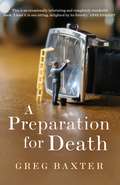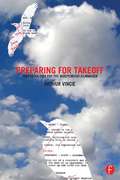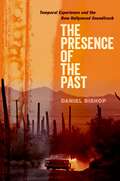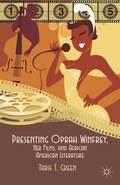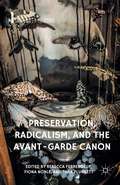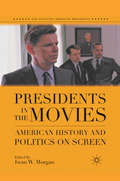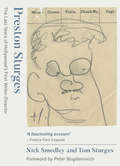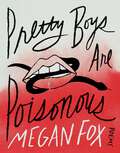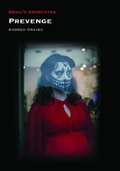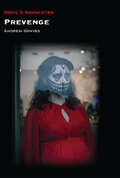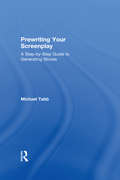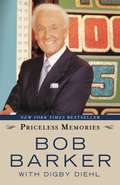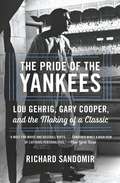- Table View
- List View
Premodern Rulers and Postmodern Viewers: Gender, Sex, and Power in Popular Culture (Queenship and Power)
by Elena Woodacre Janice North Karl C. AlvestadPop culture portrayals of medieval and early modern monarchs are rife with tension between authenticity and modern mores, producing anachronisms such as a feminist Queen Isabel (in RTVE’s Isabel) and a lesbian Queen Christina (in The Girl King). This book examines these anachronisms as a dialogue between premodern and postmodern ideas about gender and sexuality, raising questions of intertemporality, the interpretation of history, and the dangers of presentism. Covering a range of famous and lesser-known European monarchs on screen, from Elizabeth I to Muhammad XII of Granada, this book addresses how the lives of powerful women and men have been mythologized in order to appeal to today’s audiences. The contributors interrogate exactly what is at stake in these portrayals; namely, our understanding of premodern rulers, the gender and sexual ideologies they navigated, and those that we navigate today.
A Preparation for Death
by Greg BaxterIn his early thirties, Greg Baxter found himself in a strange place. He hated his job, he was drinking excessively, he was sabotaging his most important relationships, and he was no longer doing the thing he cared about most: writing. Strangest of all, at this time he started teaching evening classes in creative writing - and his life changed utterly.A Preparation for Death is a document of the chaos and discovery of that time and of the experiences that led Greg Baxter to that strange place - an extraordinarily intimate account of literary failure (and its consequences), personal decay, and redemption through reading, writing, and truth-telling. 'Brilliant and wonderfully original ... Yes, this is a book about drinking and shagging. But rarely have these things been written about so well' William Leith, Literary Review'Baxter is a serious, thoughtful writer, bend on emotional truth and artistry. He has written an unusual, provocative book' Suzi Feay, Financial Times'Brave, honest and propulsive' Metro'The triumph is the steely courage it takes to put a life down with such uncompromising clarity' Hugo Hamilton, Irish Times'This is an occasionally infuriating and completely wonderful book. I read it in one sitting, unsettled and delighted by its ferocity' Anne Enright
Preparing For Takeoff: Preproduction for the Independent Filmmaker
by Arthur VincieYou have the camera, time, money (or credit card), so why don't you just start shooting? Preparing for Takeoff will give you the tools you need to fully prepare for your independent film. This book features: Vital preproduction tips on scheduling, previsualization, script analysis, location scouting, budgeting, hiring vendors, and clearing permits A detailed analysis of the role both producers and directors play in the preproduction process Crucial advice on how to prepare for postproduction and distribution while still in the early stages of making a film Lessons from the field in how to avoid mid-shoot changes, unhappy actors, fostering a resentful crew, wasted days and dwindling finances An accompanying website that includes sample script analyses, storyboards, beat sheets, editable budget forms, and more
Preparing For Takeoff: Preproduction for the Independent Filmmaker
by Arthur VincieYou have the camera, time, money (or credit card), so why don't you just start shooting? Preparing for Takeoff will give you the tools you need to fully prepare for your independent film. This book features: Vital preproduction tips on scheduling, previsualization, script analysis, location scouting, budgeting, hiring vendors, and clearing permits A detailed analysis of the role both producers and directors play in the preproduction process Crucial advice on how to prepare for postproduction and distribution while still in the early stages of making a film Lessons from the field in how to avoid mid-shoot changes, unhappy actors, fostering a resentful crew, wasted days and dwindling finances An accompanying website that includes sample script analyses, storyboards, beat sheets, editable budget forms, and more
Prepping and Shooting Your Student Short Film: A Brief Guide to Film Production
by Rory KellyFocusing on the practical tools required to making your first student film, this book is a concise and accessible guide to film production. Demystifying the process of taking a film from concept through to production, author Rory Kelly covers all the key bases including: organizing your script, when and how to shoot, production budgeting, finding actors and locations, and roadmapping postproduction. Featuring common problems and challenges producers and directors face throughout the production process and providing practical solutions, the book illustrates how to effectively create a film that can be successfully shot in a classroom or micro-budget environment. Filmmakers will be empowered to prioritize realistic goals, balance practical and creative demands, manage a budget, and schedule time to ensure concept translates to reality. Kelly brings together the creative process and practicalities of producing a student film. A concise and accessible guide written with the specific constraints of a student production in mind, this book will equip any filmmaker with the tools to produce an impactful short film. Ideal for undergraduate and graduate students of filmmaking, amateur filmmakers, as well as students in high school, community-based, for-profit and summer filmmaking programs. Additional downloadable online resources include a look-book with images and video clips, as well as printable budget templates, shooting schedule templates, block breakdown sheets, a digital workflow worksheet, timed shot-list forms and templates for location agreements, appearance releases, crew deal memos and call sheets.
Prepping and Shooting Your Student Short Film: A Brief Guide to Film Production
by Rory KellyFocusing on the practical tools required to making your first student film, this book is a concise and accessible guide to film production. Demystifying the process of taking a film from concept through to production, author Rory Kelly covers all the key bases including: organizing your script, when and how to shoot, production budgeting, finding actors and locations, and roadmapping postproduction. Featuring common problems and challenges producers and directors face throughout the production process and providing practical solutions, the book illustrates how to effectively create a film that can be successfully shot in a classroom or micro-budget environment. Filmmakers will be empowered to prioritize realistic goals, balance practical and creative demands, manage a budget, and schedule time to ensure concept translates to reality. Kelly brings together the creative process and practicalities of producing a student film. A concise and accessible guide written with the specific constraints of a student production in mind, this book will equip any filmmaker with the tools to produce an impactful short film. Ideal for undergraduate and graduate students of filmmaking, amateur filmmakers, as well as students in high school, community-based, for-profit and summer filmmaking programs. Additional downloadable online resources include a look-book with images and video clips, as well as printable budget templates, shooting schedule templates, block breakdown sheets, a digital workflow worksheet, timed shot-list forms and templates for location agreements, appearance releases, crew deal memos and call sheets.
The Presence of the Past: Temporal Experience and the New Hollywood Soundtrack (Oxford Music / Media)
by Daniel BishopThe Presence of the Past offers a new perspective on Hollywood's "New Wave" as engaged with the vitality of sensory experience and the affective imagination. As author Daniel Bishop shows, the soundtracks of several key films of the New Hollywood Cinema of the late 1960s and 70s cultivated an array of sensibilities regarding the American past. This importance of the past exceeded the New Hollywood's acknowledged use of genre revisionism as a vehicle for timely ideological commentary. There was also a vital tendency in this era to locate the past as an object of imagined phenomenal presence. Although this concept of the past never solidified into a self-conscious discourse, it was nevertheless woven into film culture, readable between the lines of criticism, cultural reception, New Wave aesthetics, and in the aesthetic and industrial transformations of sound design and film music. Bonnie and Clyde (1967), Butch Cassidy and the Sundance Kid (1969), McCabe and Mrs. Miller (1971), The Last Picture Show (1971), American Graffiti (1973), Chinatown (1974), and Badlands (1973) are not only key texts of an exciting era in American popular cinema. They are also mediations upon the presence of the past, an image central to the polarities of visceral energy and ambiguous ephemerality, of utopian dreams and melancholy resignation that characterized this cinema. These sensibilities of pastness engage in diverse ways with myth, nostalgia, paranoia, and existential alienation. They are, however, also united by a concern both with the experiential actuality of the past and with the distances that inevitably separate us from this actuality.
The Presence of the Past: Temporal Experience and the New Hollywood Soundtrack (Oxford Music / Media)
by Daniel BishopThe Presence of the Past offers a new perspective on Hollywood's "New Wave" as engaged with the vitality of sensory experience and the affective imagination. As author Daniel Bishop shows, the soundtracks of several key films of the New Hollywood Cinema of the late 1960s and 70s cultivated an array of sensibilities regarding the American past. This importance of the past exceeded the New Hollywood's acknowledged use of genre revisionism as a vehicle for timely ideological commentary. There was also a vital tendency in this era to locate the past as an object of imagined phenomenal presence. Although this concept of the past never solidified into a self-conscious discourse, it was nevertheless woven into film culture, readable between the lines of criticism, cultural reception, New Wave aesthetics, and in the aesthetic and industrial transformations of sound design and film music. Bonnie and Clyde (1967), Butch Cassidy and the Sundance Kid (1969), McCabe and Mrs. Miller (1971), The Last Picture Show (1971), American Graffiti (1973), Chinatown (1974), and Badlands (1973) are not only key texts of an exciting era in American popular cinema. They are also mediations upon the presence of the past, an image central to the polarities of visceral energy and ambiguous ephemerality, of utopian dreams and melancholy resignation that characterized this cinema. These sensibilities of pastness engage in diverse ways with myth, nostalgia, paranoia, and existential alienation. They are, however, also united by a concern both with the experiential actuality of the past and with the distances that inevitably separate us from this actuality.
Presence & Pre-Express 2
by YarrowFirst Published in 1997. Routledge is an imprint of Taylor & Francis, an informa company.
Presence & Pre-Express 2
by YarrowFirst Published in 1997. Routledge is an imprint of Taylor & Francis, an informa company.
Presenting Oprah Winfrey, Her Films, and African American Literature
by Tara T. GreenOprah Winfrey has long promoted black issues by being involved as a producer or actor in the adaptation of works by African American writers for film. This volume evaluates Winfrey's involvement in the visual interpretation of African American literary texts using film, music, black masculinity, black feminist, and cultural theory.
Preservation, Radicalism, and the Avant-Garde Canon (Avant-Gardes in Performance)
by R. Ferreboeuf F. Noble T. PlunkettCombining a range of content with self-reflexive examination by scholars and practitioners, this edited volume interrogates the contemporary significance of the avant-garde. Rather than focusing on a particular region, period, or movement, the contributors bring together case studies to examine what constitutes the avant-garde canon.
The President Electric: Ronald Reagan and the Politics of Performance (Theater: Theory/Text/Performance)
by Timothy Raphael"In this illuminating, multi-pronged cultural and performance history of such phenomena as Chautauqua and radio, movies, and electrical technology, Timothy Raphael puts together a compelling and sometimes revelatory narrative of how commandingly Reagan mastered the matrix of performance, technology, media, celebrity, and the 'republic of consumption' he came of age in." ---Dana Nelson, Vanderbilt University "Garry Wills and others have written well on the phenomenon of Ronald Reagan, the actor-president, but this is the first book by a real authority---trained in performance and fully reflective about it from the inside . . . unquestionably an important contribution to the disciplinary fields of American studies and performance studies, and an important contribution to public affairs." ---Joseph Roach, Yale University When Ronald Reagan first entered politics in 1965, his public profile as a performer in radio, film, television, and advertising and his experience in public relations proved invaluable political assets. By the time he left office in 1989, the media in which he trained had become the primary source for generating and wielding political power. The President Electric: Ronald Reagan and the Politics of Performance reveals how the systematic employment of the techniques and technologies of mass-media performance contributed to Reagan’s rise to power and defined his style of governance. The President Electric stands out among books on Reagan as the first to bring the rich insights of the field of performance studies to an understanding of the Reagan phenomenon, connecting Reagan's training in electronic media to the nineteenth-century notion of the "fiat of electricity"---the emerging sociopolitical power of three entities (mechanical science, corporate capitalism, and mass culture) that electric technology made possible. The book describes how this new regime of cultural and political representation shaped the development of the electronic mass media that transformed American culture and politics and educated Ronald Reagan for his future role as president. Timothy Raphael is Assistant Professor of Visual and Performing Arts and Director of the Center for Immigration at Rutgers University, Newark. Photo: © David H. Wells/Corbis
Presidents in the Movies: American History and Politics on Screen (The Evolving American Presidency)
by Iwan W. MorganCinematic depictions of real U.S. presidents from Abraham Lincoln to George W. Bush explore how Hollywood movies represent American history and politics on screen. Morgan and his contributors show how films blend myth and reality to present a positive message about presidents as the epitome of America's values and idealism until unpopular foreign wars in Vietnam and Iraq led to a darker portrayal of the imperial presidency, operated by Richard Nixon and Bush 43. This exciting new collection further considers how Hollywood has continually reinterpreted historically significant presidents, notably Abraham Lincoln, Theodore Roosevelt, and Franklin D. Roosevelt, to fit the times in which movies about them were made.
Press Freedoms: A Descriptive Calendar of Concepts, Interpretations, Events, and Court Actions, From 4000 B.C. to the Present
by Louis E. IngelhartThis interesting and unusual work examines the events, concepts, and interpretations that led to the emergence of the idea of freedom of the press in the United States and to the recognition of the concept of a free press in more than one hundred other countries. The calendar extends from the year 4000 BC to the present and chronicles the historical progress of freedom of the press, involving thousands of persons and thousands of publishing and media efforts, including newspapers, books, pamphlets, radio, television, and motion pictures. This in-depth study reports and examines the many events and circumstances which had considerable impact on creating freedom of the press, explores the subject in practical terms, and shows the idea of a free press as an ever-evolving and developing concept.
The Press in the Middle East and North Africa, 1850-1950: Politics, Social History and Culture
by Anthony Gorman Didier MonciaudThe first book to look critically at digital technologies and the role they play within queer lives in contemporary India
The Press in the Middle East and North Africa, 1850-1950: Politics, Social History and Culture (Edinburgh University Press)
by Anthony Gorman Didier MonciaudA dynamic, scholarly engagement with Susanne Bier’s work
Preston Sturges: The Last Years Of Hollywood's First Writer-director
by Nick Smedley Tom SturgesFew directors of the 1930s and 40s were as distinctive and popular as Preston Sturges, whose whipsmart comedies have entertained audiences for decades. This book offers a new critical appreciation of Sturges’ whole oeuvre, incorporating a detailed study of the last ten years of his life from new primary sources.
Pretty Boys Are Poisonous: Poems: A Collection of F**ked Up Fairy Tales
by Megan FoxMegan Fox showcases her wicked humor throughout a heartbreaking and dark collection of poetry. Over the course of more than 80 poems, Fox chronicles all the ways in which we fit ourselves into the shape of the ones we love, even if it means losing ourselves in the process."These poems were written in an attempt to excise the illness that had taken root in me because of my silence. I've spent my entire life keeping the secrets of men, my body aches from carrying the weight of their sins. My freedom lives in these pages, and I hope that my words can inspire others to take back their happiness and their identity by using their voice to illuminate what's been buried, but not forgotten, in the darkness," says Fox.Pretty Boys Are Poisonous marks the powerful debut from one of the most well-known women of our time. Turn the page, bite the apple, and sink your teeth into the most deliciously compelling and addictive book you'll read all year.
Prevenge (Devil's Advocates)
by Andrew GravesPrevenge (2016) is an entertainingly dark 21st-century horror movie detailing the serial killing journey of heavily pregnant Ruth. It’s a cleverly crafted narrative full of stark social commentary, traversing the delicate line between comedy and tragedy by fusing together a kitchen sink approach with a supernatural revenge plot. This book, as part of the Devil’s Advocates series, examines how the film deconstructs the slasher mythology and the sexism therein, and upends stereotypical representations of the ‘weak’ woman and ‘delicate’ mother. With new exclusive input from writer, director and star Alice Lowe, the text also looks at the production’s inception and development, assesses its debts to cult British cinema, and inspects its umbilical connections to Rosemary’s Baby, Alien, Village of the Damned and many other ‘Monstrous Child’ silver screen features.
Prevenge (Devil's Advocates)
by Andrew GravesPrevenge (2016) is an entertainingly dark 21st-century horror movie detailing the serial killing journey of heavily pregnant Ruth. It’s a cleverly crafted narrative full of stark social commentary, traversing the delicate line between comedy and tragedy by fusing together a kitchen sink approach with a supernatural revenge plot. This book, as part of the Devil’s Advocates series, examines how the film deconstructs the slasher mythology and the sexism therein, and upends stereotypical representations of the ‘weak’ woman and ‘delicate’ mother. With new exclusive input from writer, director and star Alice Lowe, the text also looks at the production’s inception and development, assesses its debts to cult British cinema, and inspects its umbilical connections to Rosemary’s Baby, Alien, Village of the Damned and many other ‘Monstrous Child’ silver screen features.
Prewriting Your Screenplay: A Step-by-Step Guide to Generating Stories
by Michael TabbPrewriting Your Screenplay cements all the bricks of a story’s foundations together and forms a single, organic story-growing technique, starting with a blank slate. It shows writers how to design each element so that they perfectly interlock together like pieces of a puzzle, creating a stronger story foundation that does not leave gaps and holes for readers to find. This construction process is performed one piece at a time, one character at a time, building and incorporating each element into the whole. The book provides a clear-cut set of lessons that teaches how to construct that story base around concepts as individual as the writer’s personal opinions, helping to foster an individual writer’s voice. It also features end-of-chapter exercises that offer step-by-step guidance in applying each lesson, providing screenwriters with a concrete approach to building a strong foundation for a screenplay. This is the quintessential book for all writers taking their first steps towards developing a screenplay from nothing, getting them over that first monumental hump, resulting in a well-formulated story concept that is cohesive and professional.
Prewriting Your Screenplay: A Step-by-Step Guide to Generating Stories
by Michael TabbPrewriting Your Screenplay cements all the bricks of a story’s foundations together and forms a single, organic story-growing technique, starting with a blank slate. It shows writers how to design each element so that they perfectly interlock together like pieces of a puzzle, creating a stronger story foundation that does not leave gaps and holes for readers to find. This construction process is performed one piece at a time, one character at a time, building and incorporating each element into the whole. The book provides a clear-cut set of lessons that teaches how to construct that story base around concepts as individual as the writer’s personal opinions, helping to foster an individual writer’s voice. It also features end-of-chapter exercises that offer step-by-step guidance in applying each lesson, providing screenwriters with a concrete approach to building a strong foundation for a screenplay. This is the quintessential book for all writers taking their first steps towards developing a screenplay from nothing, getting them over that first monumental hump, resulting in a well-formulated story concept that is cohesive and professional.
Priceless Memories
by Bob Barker Digby DiehlIn front of the camera, he has been invited into the homes of millions of Americans as host of The Price Is Right, Truth or Consequences, Miss USA, Miss Universe, The Rose Parade, and many other programs and specials. Now Bob Barker shares stories of favorite contestants, episodes, celebrity encounters, and behind-the-scenes happenings. Beyond his public persona, he will open up about his personal life. From being raised on a Native American reservation by a single mother through the Great Depression and the Dust Bowl, to training as a pilot in the Navy during World War II, through his romance with the love of his life and high school sweetheart, Dorothy Jo, and his success at retirement. His support of animal rights has always been a central part of his life. Bob delves into stories of how he has taken on Hollywood and the government in his crusade, including his anti-fur stand-off with beauty pageants, his involvement in uncovering animal abuse in movies and television, and the legislation he helped to pass. He also shares personal stories of rescuing animals, from dogs to elephants. For the innumerable fans who have welcomed Bob into their homes over the last fifty years, this book will be like catching up with a dear and familiar friend who continues to lead a full and endlessly interesting life.
The Pride of the Yankees: Lou Gehrig, Gary Cooper, and the Making of a Classic
by Richard Sandomir"I CONSIDER MYSELF THE LUCKIEST MAN ON THE FACE OF THE EARTH."On July 4, 1939, baseball great Lou Gehrig delivered what has been called "baseball's Gettysburg Address" at Yankee Stadium and gave a speech that included the phrase that would become legendary. He died two years later and his fiery widow, Eleanor, wanted nothing more than to keep his memory alive. With her forceful will, she and the irascible producer Samuel Goldwyn quickly agreed to make a film based on Gehrig's life, The Pride of the Yankees. Goldwyn didn't understand--or care about--baseball. For him this film was the emotional story of a quiet, modest hero who married a spirited woman who was the love of his life, and, after a storied career, gave a short speech that transformed his legacy. With the world at war and soldiers dying on foreign soil, it was the kind of movie America needed. Using original scrips, letters, memos, and other rare documents, Richard Sandomir tells the behind-the-scenes story of how a classic was born. There was the so-called Scarlett O'Hara-like search to find the actor to play Gehrig; the stunning revelations Elanor made to the scriptwriter Paul Gallico about her life with Lou; the intensive training Cooper underwent to learn how to catch, throw, and hit a baseball for the first time; and the story of two now-legendary Hollywood actors in Gary Cooper and Teresa Wright whose nuanced performances endowed the Gehrigs with upstanding dignity and cemented the baseball icon's legend. Sandomir writes with great insight and aplomb, painting a fascinating portrait of a bygone Hollywood era, a mourning widow with a dream, and the shadow a legend cast on one of the greatest sports films of all time.

